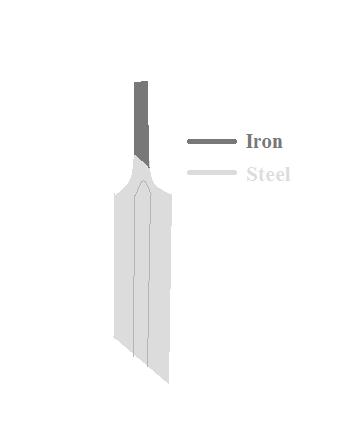| Author |
Message |
Jared Smith

|
 Posted: Tue 13 Oct, 2009 2:13 pm Post subject: heat treatment of tang? Posted: Tue 13 Oct, 2009 2:13 pm Post subject: heat treatment of tang? |
 |
|
I am wondering what our better blade-smiths philosophies are regarding completeness of heat treat all the way through the tang.
I saw a comment on a blacksmith/ blade-smith forum that sounded like an individual was advocating deliberately NOT heat treating the tang area of swords.
I can understand that tongs or a fixture typically obstructs part of the tang for handling purposes during quench, etc. But, I would have expected as much of the tang to be heat treated as practical. (Small end portion of tang sticking out of pommel should not really matter if it is going to be hot peened later.) Spring like temper in the shoulder to tang transition area would seem critical. Would a tang be left annealed to make interference fit assembly more easily accomplished or something?
Absence of evidence is not necessarily evidence of absence!
|
|
  |
 |
|
Jim Mearkle
|
 Posted: Tue 13 Oct, 2009 2:47 pm Post subject: Posted: Tue 13 Oct, 2009 2:47 pm Post subject: |
 |
|
The whole sword should be heat treated, but different parts have different needs. Like the back of a differentially tapered Japanese sword, the tang needs to be tough, not hard. It would be more accurate to say the tang should not be hardened.
Jim
|
|
  |
 |
|
Hadrian Coffin
Industry Professional
Location: Oxford, England Joined: 03 Apr 2008
Posts: 404
|
 Posted: Tue 13 Oct, 2009 3:25 pm Post subject: Posted: Tue 13 Oct, 2009 3:25 pm Post subject: |
 |
|
Hello,
Brilliant question, I see an interesting discussion developing. Modern bladesmith's takes on this will vary depending upon what the smith is trying to accomplish. Smiths using modern materials making high performance blades will have a different approach than smiths forging in bloomery iron on a coal forge. If we are speaking historically than it will vary by time period. Many medieval swords are made using a steel blade with a scarf welded iron tang, the difficulty is determining if these were tang extensions due to re-fit hilts or the original make up. The advantage of utilizing an iron tang (the iron will of course not be heat treated, as iron can not be heat treated) is that it is easy to peen and will bend rather than break, allowing more stress to be put onto the tang without failure. Not hardening and tempering a steel tang should give you similar results. Shown below is (a very crude) diagram of a type X sword I recently made.
Cheers,
Hadrian
 Attachment: 5.2 KB Attachment: 5.2 KB

Historia magistra vitae est
|
|
   |
 |
Craig Johnson
Industry Professional

|
 Posted: Tue 13 Oct, 2009 3:56 pm Post subject: Re: heat treatment of tang? Posted: Tue 13 Oct, 2009 3:56 pm Post subject: Re: heat treatment of tang? |
 |
|
| Jared Smith wrote: | | Spring like temper in the shoulder to tang transition area would seem critical. Would a tang be left annealed to make interference fit assembly more easily accomplished or something? |
Hi Jared
Actually it would be the exact opposite as the guys above have mentioned. The tang would not be left annealed as if it is iron it can not be hardened. Even if heated and quenched iron will not take a quench.
The diagram by Hadrian shows what was often done but I have seen several examples even more so. The blade will be attached to the iron area 2 or 3 inches into the blade. One of the best examples was on a sword Bill Grandy has, really a great example.
Best
Craig
|
|
    |
 |
Jared Smith

|
 Posted: Tue 13 Oct, 2009 7:47 pm Post subject: Posted: Tue 13 Oct, 2009 7:47 pm Post subject: |
 |
|
I can understand the futility of trying to harden a historically accurate iron tang. Then again, we have so many CNC machined all alloy mono-steel reproductions today that alternative and modern heat treat options are possible. (Maybe not smart in terms of tang failure, but at least possible.) From the responses so far, I take it most do not harden the tang even in modern reproductions?
The issue matters as I am contemplating a propane fired heat treat oven length. (55 gallon drum type similar to Don Fogg's or discarded hot water heater tank style similar to Jesus Hernadez's.)
Absence of evidence is not necessarily evidence of absence!
|
|
  |
 |
Jean Thibodeau

|
 Posted: Tue 13 Oct, 2009 8:04 pm Post subject: Posted: Tue 13 Oct, 2009 8:04 pm Post subject: |
 |
|
Just an opinion but a modern steel heat treated to a moderate hardness around 50 rc to 55 rc need not be considered particularly brittle and prone to breaking.
A spring tempered steel maybe a little softer in the 40Rc to 45 rc range is stronger than the same steel as dead soft and won't bend and be damaged by taking a set and still be soft enough to not be brittle.
Now, I think that Tinker differentially tempers many of his swords after heat treating the whole thing: The tang, blade shoulders and the center of blade as well as the last few inches near the point are selectively softened ( tempered ) to vary the shock resistance along the blade to optimize hardness at the cutting edge and relative softness where needed.
If you read through some of the specifications on the swords Tinker makes on his site give different heat treatment for different swords and different hardness within the same sword.
http://www.tinkerswords.com/Page%203.html
You can easily give up your freedom. You have to fight hard to get it back!
|
|
  |
 |
|
|

